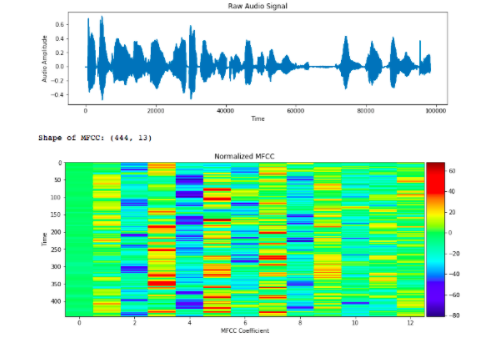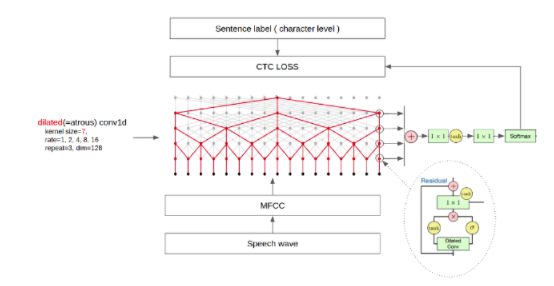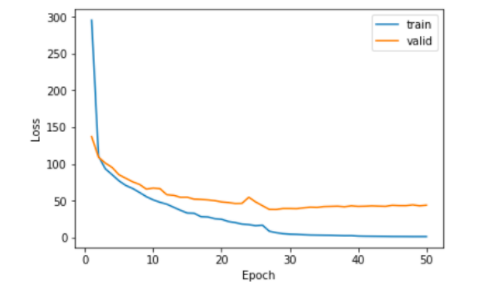用 Python 訓練自己的語音識別系統,這波操作穩了
近幾年來語音識別技術得到了迅速發展,從手機中的Siri語音智能助手、微軟的小娜以及各種平臺的智能音箱等等,各種語音識別的項目得到了廣泛應用。
語音識別屬于感知智能,而讓機器從簡單的識別語音到理解語音,則上升到了認知智能層面,機器的自然語言理解能力如何,也成為了其是否有智慧的標志,而自然語言理解正是目前難點。
同時考慮到目前大多數的語音識別平臺都是借助于智能云,對于語音識別的訓練對于大多數人而言還較為神秘,故今天我們將利用python搭建自己的語音識別系統。
最終模型的識別效果如下:
實驗前的準備
首先我們使用的python版本是3.6.5所用到的庫有cv2庫用來圖像處理;
Numpy庫用來矩陣運算;Keras框架用來訓練和加載模型。Librosa和python_speech_features庫用于提取音頻特征。Glob和pickle庫用來讀取本地數據集。
數據集準備
首先數據集使用的是清華大學的thchs30中文數據。
這些錄音根據其文本內容分成了四部分,A(句子的ID是1~250),B(句子的ID是251~500),C(501~750),D(751~1000)。ABC三組包括30個人的10893句發音,用來做訓練,D包括10個人的2496句發音,用來做測試。
data文件夾中包含(.wav文件和.trn文件;trn文件里存放的是.wav文件的文字描述:第一行為詞,第二行為拼音,第三行為音素);
數據集如下:
模型訓練
1、提取語音數據集的MFCC特征:
首先人的聲音是通過聲道產生的,聲道的形狀決定了發出怎樣的聲音。如果我們可以準確的知道這個形狀,那么我們就可以對產生的音素進行準確的描述。聲道的形狀在語音短時功率譜的包絡中顯示出來。而MFCCs就是一種準確描述這個包絡的一種特征。
其中提取的MFCC特征如下圖可見。
故我們在讀取數據集的基礎上,要將其語音特征提取存儲以方便加載入神經網絡進行訓練。
其對應的代碼如下:
- #讀取數據集文件
- text_paths = glob.glob('data/*.trn')
- total = len(text_paths)
- print(total)
- with open(text_paths[0], 'r', encoding='utf8') as fr:
- lines = fr.readlines
- print(lines)
- #數據集文件trn內容讀取保存到數組中
- texts =
- paths =
- for path in text_paths:
- with open(path, 'r', encoding='utf8') as fr:
- lines = fr.readlines
- line = lines[0].strip('\n').replace(' ', '')
- texts.append(line)
- paths.append(path.rstrip('.trn'))
- print(paths[0], texts[0])
- #定義mfcc數
- mfcc_dim = 13
- #根據數據集標定的音素讀入
- def load_and_trim(path):
- audio, sr = librosa.load(path)
- energy = librosa.feature.rmse(audio)
- frames = np.nonzero(energy >= np.max(energy) / 5)
- indices = librosa.core.frames_to_samples(frames)[1]
- audio = audio[indices[0]:indices[-1]] if indices.size else audio[0:0]
- return audio, sr
- #提取音頻特征并存儲
- features =
- for i in tqdm(range(total)):
- path = paths[i]
- audio, sr = load_and_trim(path)
- features.append(mfcc(audio, sr, numcep=mfcc_dim, nfft=551))
- print(len(features), features[0].shape)
2、神經網絡預處理:
在進行神經網絡加載訓練前,我們需要對讀取的MFCC特征進行歸一化,主要目的是為了加快收斂,提高效果和減少干擾。然后處理好數據集和標簽定義輸入和輸出即可。
對應代碼如下:
- #隨機選擇100個數據集
- samples = random.sample(features, 100)
- samples = np.vstack(samples)
- #平均MFCC的值為了歸一化處理
- mfcc_mean = np.mean(samples, axis=0)
- #計算標準差為了歸一化
- mfcc_std = np.std(samples, axis=0)
- print(mfcc_mean)
- print(mfcc_std)
- #歸一化特征
- features = [(feature - mfcc_mean) / (mfcc_std + 1e-14) for feature in features]
- #將數據集讀入的標簽和對應id存儲列表
- chars = {}
- for text in texts:
- for c in text:
- chars[c] = chars.get(c, 0) + 1
- chars = sorted(chars.items, key=lambda x: x[1], reverse=True)
- chars = [char[0] for char in chars]
- print(len(chars), chars[:100])
- char2id = {c: i for i, c in enumerate(chars)}
- id2char = {i: c for i, c in enumerate(chars)}
- data_index = np.arange(total)
- np.random.shuffle(data_index)
- train_size = int(0.9 * total)
- test_size = total - train_size
- train_index = data_index[:train_size]
- test_index = data_index[train_size:]
- #神經網絡輸入和輸出X,Y的讀入數據集特征
- X_train = [features[i] for i in train_index]
- Y_train = [texts[i] for i in train_index]
- X_test = [features[i] for i in test_index]
- Y_test = [texts[i] for i in test_index]
3、神經網絡函數定義:
其中包括訓練的批次,卷積層函數、標準化函數、激活層函數等等。
其中第⼀個維度為⼩⽚段的個數,原始語⾳越長,第⼀個維度也越⼤, 第⼆個維度為 MFCC 特征的維度。得到原始語⾳的數值表⽰后,就可以使⽤ WaveNet 實現。由于 MFCC 特征為⼀維序列,所以使⽤ Conv1D 進⾏卷積。 因果是指,卷積的輸出只和當前位置之前的輸⼊有關,即不使⽤未來的 特征,可以理解為將卷積的位置向前偏移。WaveNet 模型結構如下所⽰:
具體如下可見:
- batch_size = 16
- #定義訓練批次的產生,一次訓練16個
- def batch_generator(x, y, batch_size=batch_size):
- offset = 0
- while True:
- offset += batch_size
- if offset == batch_size or offset >= len(x):
- data_index = np.arange(len(x))
- np.random.shuffle(data_index)
- x = [x[i] for i in data_index]
- y = [y[i] for i in data_index]
- offset = batch_size
- X_data = x[offset - batch_size: offset]
- Y_data = y[offset - batch_size: offset]
- X_maxlen = max([X_data[i].shape[0] for i in range(batch_size)])
- Y_maxlen = max([len(Y_data[i]) for i in range(batch_size)])
- X_batch = np.zeros([batch_size, X_maxlen, mfcc_dim])
- Y_batch = np.ones([batch_size, Y_maxlen]) * len(char2id)
- X_length = np.zeros([batch_size, 1], dtype='int32')
- Y_length = np.zeros([batch_size, 1], dtype='int32')
- for i in range(batch_size):
- X_length[i, 0] = X_data[i].shape[0]
- X_batch[i, :X_length[i, 0], :] = X_data[i]
- Y_length[i, 0] = len(Y_data[i])
- Y_batch[i, :Y_length[i, 0]] = [char2id[c] for c in Y_data[i]]
- inputs = {'X': X_batch, 'Y': Y_batch, 'X_length': X_length, 'Y_length': Y_length}
- outputs = {'ctc': np.zeros([batch_size])}
- epochs = 50
- num_blocks = 3
- filters = 128
- X = Input(shape=(None, mfcc_dim,), dtype='float32', name='X')
- Y = Input(shape=(None,), dtype='float32', name='Y')
- X_length = Input(shape=(1,), dtype='int32', name='X_length')
- Y_length = Input(shape=(1,), dtype='int32', name='Y_length')
- #卷積1層
- def conv1d(inputs, filters, kernel_size, dilation_rate):
- return Conv1D(filters=filters, kernel_size=kernel_size, strides=1, padding='causal', activation=None,
- dilation_rate=dilation_rate)(inputs)
- #標準化函數
- def batchnorm(inputs):
- return BatchNormalization(inputs)
- #激活層函數
- def activation(inputs, activation):
- return Activation(activation)(inputs)
- #全連接層函數
- def res_block(inputs, filters, kernel_size, dilation_rate):
- hf = activation(batchnorm(conv1d(inputs, filters, kernel_size, dilation_rate)), 'tanh')
- hg = activation(batchnorm(conv1d(inputs, filters, kernel_size, dilation_rate)), 'sigmoid')
- h0 = Multiply([hf, hg])
- ha = activation(batchnorm(conv1d(h0, filters, 1, 1)), 'tanh')
- hs = activation(batchnorm(conv1d(h0, filters, 1, 1)), 'tanh')
- return Add([ha, inputs]), hs
- h0 = activation(batchnorm(conv1d(X, filters, 1, 1)), 'tanh')
- shortcut =
- for i in range(num_blocks):
- for r in [1, 2, 4, 8, 16]:
- h0, s = res_block(h0, filters, 7, r)
- shortcut.append(s)
- h1 = activation(Add(shortcut), 'relu')
- h1 = activation(batchnorm(conv1d(h1, filters, 1, 1)), 'relu')
- #softmax損失函數輸出結果
- Y_pred = activation(batchnorm(conv1d(h1, len(char2id) + 1, 1, 1)), 'softmax')
- sub_model = Model(inputs=X, outputs=Y_pred)
- #計算損失函數
- def calc_ctc_loss(args):
- y, yp, ypl, yl = args
- return K.ctc_batch_cost(y, yp, ypl, yl)
4、模型的訓練:
訓練的過程如下可見:
- ctc_loss = Lambda(calc_ctc_loss, output_shape=(1,), name='ctc')([Y, Y_pred, X_length, Y_length])
- #加載模型訓練
- model = Model(inputs=[X, Y, X_length, Y_length], outputs=ctc_loss)
- #建立優化器
- optimizer = SGD(lr=0.02, momentum=0.9, nesterov=True, clipnorm=5)
- #激活模型開始計算
- model.compile(loss={'ctc': lambda ctc_true, ctc_pred: ctc_pred}, optimizer=optimizer)
- checkpointer = ModelCheckpoint(filepath='asr.h5', verbose=0)
- lr_decay = ReduceLROnPlateau(monitor='loss', factor=0.2, patience=1, min_lr=0.000)
- #開始訓練
- history = model.fit_generator(
- generator=batch_generator(X_train, Y_train),
- steps_per_epoch=len(X_train) // batch_size,
- epochs=epochs,
- validation_data=batch_generator(X_test, Y_test),
- validation_steps=len(X_test) // batch_size,
- callbacks=[checkpointer, lr_decay])
- #保存模型
- sub_model.save('asr.h5')
- #將字保存在pl=pkl中
- with open('dictionary.pkl', 'wb') as fw:
- pickle.dump([char2id, id2char, mfcc_mean, mfcc_std], fw)
- train_loss = history.history['loss']
- valid_loss = history.history['val_loss']
- plt.plot(np.linspace(1, epochs, epochs), train_loss, label='train')
- plt.plot(np.linspace(1, epochs, epochs), valid_loss, label='valid')
- plt.legend(loc='upper right')
- plt.xlabel('Epoch')
- plt.ylabel('Loss')
- plt.show
測試模型
讀取我們語音數據集生成的字典,通過調用模型來對音頻特征識別。
代碼如下:
- wavs = glob.glob('A2_103.wav')
- print(wavs)
- with open('dictionary.pkl', 'rb') as fr:
- [char2id, id2char, mfcc_mean, mfcc_std] = pickle.load(fr)
- mfcc_dim = 13
- model = load_model('asr.h5')
- index = np.random.randint(len(wavs))
- print(wavs[index])
- audio, sr = librosa.load(wavs[index])
- energy = librosa.feature.rmse(audio)
- frames = np.nonzero(energy >= np.max(energy) / 5)
- indices = librosa.core.frames_to_samples(frames)[1]
- audio = audio[indices[0]:indices[-1]] if indices.size else audio[0:0]
- X_data = mfcc(audio, sr, numcep=mfcc_dim, nfft=551)
- X_data = (X_data - mfcc_mean) / (mfcc_std + 1e-14)
- print(X_data.shape)
- pred = model.predict(np.expand_dims(X_data, axis=0))
- pred_ids = K.eval(K.ctc_decode(pred, [X_data.shape[0]], greedy=False, beam_width=10, top_paths=1)[0][0])
- pred_ids = pred_ids.flatten.tolist
- print(''.join([id2char[i] for i in pred_ids]))
- yield (inputs, outputs)
到這里,我們整體的程序就搭建完成,下面為我們程序的運行結果:
源碼地址:
https://pan.baidu.com/s/1tFlZkMJmrMTD05cd_zxmAg
提取碼:ndrr
數據集需要自行下載。












































